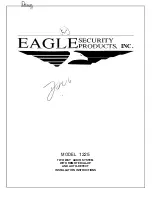
7
8
Operation
General Specifications
Frequency Allocation and Compatibility
A = Channel No. for 22 Channel Models
B = Frequency in MHz
C = Power Output
A B C
1
462.5625
High
2 462.5875 High
3
462.6125
High
4
462.6375
High
5
462.6625
High
6
462.6875
High
7
462.7125
High
8
467.5625
Low
9
467.5875
Low
10 467.6125 Low
11
467.6375
Low
12
467.6625
Low
13
467.6875
Low
14
467.7125
Low
15
462.5500
High
16
462.5750
High
17
462.6000
High
18
462.6250
High
19
462.6500
High
20
462.6750
High
21
462.7000
High
22
462.7250
High
MODEL DXFRS220:
This device complies with part 15 of the FCC Rules. Operation is subject to the
following two conditions: 1) This device may not cause harmful interference, and 2)
this device must accept any interference received,including interference that may
cause undesired operation.
FCC Warnings: Replacement or substitution of transistors, regular diodes or other parts
of a unique nature, with parts other than those recommended by D
E
WALT may cause a
violation of the technical regulations of part 95 of the FCC rules, or violation of type
acceptance requirements of part 2 of the rules.
IMPORTANT NOTICE:
WARNING:
Changes or modifications to this unit not expressly approved by the party responsible
for compliance could void the user’s authority to operate the equipment.
This device complies with Part 15 of the FCC Rules. Operation is subject to the following two
conditions: 1) This device may not cause harmful interference, and 2) this device must accept any
interference received,including interference that may cause undesired operation.
NOTE:
This equipment has been tested and found to comply with the limits for a Class B digital
device, pursuant to Part 15 of the FCC Rules. These limits are designed to provide reasonable
protection against harmful interference in a residential installation. This equipment generates, uses
and can radiate radio frequency energy and, if not installed and used in accordance with the
instructions, may cause harmful interference to radio communications.
However, there is no guarantee that interference will not occur in a particular installation. If this
equipment does cause harmful interference to radio or television reception, which can be
determined by turning the equipment off and on, the user is encouraged to try to correct the
interference by one or more of the following measures:
• Reorient or relocate the receiving antenna.
• Increase the separation between the equipment and receiver.
• Connect the equipment into an outlet on a circuit different from that to which the receiver is
connected.
• Consult the dealer or an experienced radio/TV technician for help.
Safety Information for Radios
Your wireless handheld portable transceiver contains a low power transmitter. When the talk button
is pushed, it sends out radio frequency (RF) signals. The device is authorized to operate at a duty
factor not to exceed 50%. In August 1996, the Federal Communications Commissions (FCC) adopted
RF exposure guidelines with safety levels for handheld wireless devices
Important
FCC RF Exposure Requirements: For body-worn operation, this radio has been tested and meets the
FCC RF exposure guidelines when used with D
E
WALT accessories supplied or designated for this
product. Use of other accessories may not ensure compliance with FCC RF exposure guidelines. Use
only the supplied antenna. Unauthorized antennas, modifications or attachments could damage the
transmitter and may violate FCC regulations.
Normal Position
Hold the transmitter approximately 2 inches from your face and speak in a normal voice, with the
antenna pointed up and away.
FCC Part 15.21 Warning Statement-
NOTE:
THE GRANTEE IS NOT RESPONSIBLE FOR ANY CHANGES OR MODIFICATIONS NOT
EXPRESSLY APPROVED BY THE PARTY RESPONSIBLE FOR COMPLIANCE. SUCH MODIFICATIONS
COULD VOID THE USER’S AUTHORITY TO OPERATE THE EQUIPMENT.
IC RSS-GEN
This device complies with ISED license-exempt RSS standard(s). Operation is subject to the following
two conditions: (1) this device may not cause interference, and (2) this device must accept any
interference, including interference that may cause undesired operation of the device.
Under ISED regulations, this radio transmitter may only operate using an antenna of a type and
maximum (or lesser) gain approved for the transmitter by ISED. To reduce potential radio
interference to other users, the antenna type and its gain should be so chosen that the equivalent
isotropically radiated power (e.i.r.p.) is not more than that necessary for successful communication.
The applicant is responsible for providing proper instructions to the user of the radio device, and any
usage restrictions, including limits of exposure durations. The user manual shall provide installation
and operation instructions, as well as any special usage conditions, to ensure compliance with SAR
and/or RF field strength limits. For instance, compliance distance shall be clearly stated in the user
manual.
Radiation Exposure Statement:
Any Changes or modifications not expressly approved by the party responsible for compliance could
void the user’s authority to operate the equipment.
For Remote controller, SAR tests are conducted using standard operating positions accepted by the
FCC/ISED with the device transmitting at its highest certified power level in all tested frequency
bands, although the SAR is determined at the highest certified power level, the actual SAR level of
the device while operating can be well below the maximum value.
Before a new model device is available for sale to the public, it must be tested and certified to the
FCC that it does not exceed the exposure limit established by the FCC/ISED, Tests for each device
are performed in positions and locations (e.g. at the ear and worn on the body) as required by the
FCC/ISED.
For body worn operation, this model device has been tested and meets the FCC/ISED RF exposure
guidelines when used with an accessory designated for this product or when used with an accessory
that Contains no metal and that positions the handset a minimum of 10 mm from the body.
Non-compliance with the above restrictions may result in violation of RF exposure guidelines.


























